ARTYCUL: A Privacy-Preserving ML-Driven Framework to Determine the Popularity of a Cultural Exhibit on Display
Abstract
1. Introduction
2. Related Work
2.1. The Existing Applications of IoT in Cultural Heritage Domain
2.2. Constraints in IoT Utilization
2.3. Motivation and Contribution
3. Materials and Methods
3.1. Determination of Artifact Popularity
3.1.1. Visitor Behavior Classification
3.1.2. The Popularity of Displayed Artifacts
3.2. Cluster Analysis
3.3. Human Figure Detection in Video Streams
3.4. The Proposed ARTYCUL System
3.4.1. ARTYCUL Architecture
3.4.2. ARTYCUL Prototype
| Algorithm 1 Pseudo-Code for visitor detection from a video streaming source |
| 1: Read CCTV video stream file 2: Set frame as video frame at time T, where T is the last epoch 3: Set scale as 1.05 for optimum human figure detection 4: Set group threshold as 1to detect each individual in frame 5: Detect and draw detection rectangles over identified human figures 6: for rectangle in detection rectangles of a frame 7: Set X as x coordinate of top, left vertex of the rectangle 8: Set Y as y coordinate top, left vertex of the rectangle 9: Set width as width of the rectangle 10: Set height as height of the rectangle recommendations 11: Set center_x as X + width/2 12: Set center_y as Y + height/2 13: Save center_x, center_yin CSV files //the CSV files will be read by Popularity estimation module 14: end for |
4. Results
5. Discussion
6. Conclusions
Author Contributions
Funding
Institutional Review Board Statement
Informed Consent Statement
Data Availability Statement
Conflicts of Interest
References
- Fleck, M.; Frid, M.; Kindberg, T.; O’Brien-Strain, E.; Rajani, R.; Spasojevic, M. From informing to remembering: Ubiquitous systems in interactive museums. IEEE Pervasive Comput. 2002, 1, 13–21. [Google Scholar] [CrossRef]
- Kuflik, T.; Stock, O.; Zancanaro, M.; Gorfinkel, A.; Jbara, S.; Kats, S.; Sheidin, J.; Kashtan, N. A visitor’s guide in an active museum: Presentations, communications, and reflection. J. Comput. Cult. Herit. 2011, 3, 25. [Google Scholar] [CrossRef]
- Vom Lehn, D.; Heath, C.; Hindmarsh, J. Conduct and Collaboration in Museums and Galleries. Symb. Interact. 2001, 24, 189–216. [Google Scholar] [CrossRef]
- Palattella, M.R.; Accettura, N.; Vilajosana, X.; Watteyne, T.; Grieco, L.A.; Boggia, G.; Dohler, M. Standardized protocol stack for the internet of (important) things. IEEE Commun. Surv. Tutor. 2013, 15, 1389–1406. [Google Scholar] [CrossRef]
- Voas, J.; Agresti, B.; Laplante, P.A. A closer look at IoTs things. IT Prof. 2018, 20, 11–14. [Google Scholar] [CrossRef]
- Rodríguez-Sánchez, M.C.; Borromeo, S.; Hernández-Tamames, J.A. Wireless sensor networks for conservation and monitoring cultural assets. IEEE Sens. J. 2011, 11, 1382–1389. [Google Scholar] [CrossRef]
- Chianese, A.; Piccialli, F. Designing a smart museum: When cultural heritage joins IoT. In Proceedings of the 2014 8th International Conference on Next Generation Mobile Applications, Services and Technologies, NGMAST, Oxford, UK, 10–12 September 2014. [Google Scholar]
- Marshall, M.T. Interacting with heritage: On the use and potential of iot within the cultural heritage sector. In Proceedings of the 2018 5th International Conference on Internet of Things: Systems, Management and Security, Valencia, Spain, 15–18 October 2018. [Google Scholar]
- Zhou, S.; Zhou, X.; Yu, Z.; Wang, K.; Wang, H.; Ni, H. A recommendation framework towards personalized services in intelligent museum. In Proceedings of the 12th IEEE International Conference on Computational Science and Engineering, CSE, Vancouver, BC, Canada, 29–31 August 2009. [Google Scholar]
- Osche, P.E.; Castagnos, S.; Napoli, A.; Naudet, Y. Walk the line: Toward an efficient user model for recommendations in museums. In Proceedings of the 11th International Workshop on Semantic and Social Media Adaptation and Personalization, SMAP, Thessaloniki, Greece, 20–21 October 2016. [Google Scholar]
- Wang, C.S.; Chen, C.L.; Hsu, W.C.; Wei, Y.C. A location-aware mobile navigation system integrating recommendation mechanism. In Proceedings of the iCAST 2012-Proceedings: 4th International Conference on Awareness Science and Technology, Seoul, Korea, 21–24 August 2012. [Google Scholar]
- Hashemi, S.H.; Hupperetz, W.; Kamps, J.; van der Vaart, M. Effects of position and time bias on understanding onsite users’ behavior. In Proceedings of the CHIIR 2016-Proceedings of the 2016 ACM Conference on Human Information Interaction and Retrieval, Chapel Hill, NC, USA, 13–17 March 2016. [Google Scholar]
- Marshall, M.T.; Dulake, N.; Petrelli, D.; Kockelkorn, H. From the deposit to the exhibit floor: An exploration on giving museum objects personality and social life. In Proceedings of the Conference on Human Factors in Computing Systems-Proceedings, Seoul, Korea, 18–23 April 2015. [Google Scholar]
- Ardito, C.; Buono, P.; Desolda, G.; Matera, M. From smart objects to smart experiences: An end-user development approach. Int. J. Hum. Comput. Stud. 2018, 114, 51–68. [Google Scholar] [CrossRef]
- Ma, J.; Liao, I.; Ma, K.L.; Frazier, J. Living liquid: Design and evaluation of an exploratory visualization tool for museum visitors. IEEE Trans. Vis. Comput. Graph. 2012, 18, 2799–2808. [Google Scholar] [CrossRef]
- Eghbal-Azar, K.; Merkt, M.; Bahnmueller, J.; Schwan, S. Use of digital guides in museum galleries: Determinants of information selection. Comput. Human Behav. 2016, 57, 133–142. [Google Scholar] [CrossRef]
- Alletto, S.; Cucchiara, R.; Del Fiore, G.; Mainetti, L.; Mighali, V.; Patrono, L.; Serra, G. An Indoor Location-Aware System for an IoT-Based Smart Museum. IEEE Internet Things J. 2016, 3, 244–253. [Google Scholar] [CrossRef]
- Wang, Y.; Yang, C.; Liu, S.; Wang, R.; Meng, X. A RFID & handheld device-based museum guide system. In Proceedings of the 2007 2nd International Conference on Pervasive Computing and Applications, ICPCA’07, Birmingham, UK, 26–27 July 2007. [Google Scholar]
- Sparacino, F. The Museum Wearable: Real-time sensor-driven understanding of visitors’ interests for personalized visually-augmented museum experiences. In Proceedings of the Museums and the Web (MW2002), Boston, MA, USA, 17–20 April 2002. [Google Scholar]
- Chianese, A.; Piccialli, F.; Valente, I. Smart environments and Cultural Heritage: A novel approach to create intelligent cultural spaces. J. Locat. Based Serv. 2015, 9, 209–234. [Google Scholar] [CrossRef]
- Benouaret, I.; Lenne, D. Personalizing the Museum Experience through Context-Aware Recommendations. In Proceedings of the 2015 IEEE International Conference on Systems, Man, and Cybernetics, SMC, Kowloon, China, 9–12 October 2015. [Google Scholar]
- Cui, B.; Zhou, W.; Fan, G.; Wu, Y. Smart mobile APP of museum-Investigations and design for local culture protection. In Proceedings of the ICCSE 2017-12th International Conference on Computer Science and Education, Houston, TX, USA, 22–25 August 2017. [Google Scholar]
- Bruns, E.; Brombach, B.; Bimber, O. Mobile phone-enabled museum guidance with adaptive classification. IEEE Comput. Graph. Appl. 2008, 28, 98–102. [Google Scholar] [CrossRef]
- Cuomo, S.; De Michele, P.; Piccialli, F.; Galletti, A.; Jung, J.E. IoT-based collaborative reputation system for associating visitors and artworks in a cultural scenario. Expert Syst. Appl. 2017, 79, 101–111. [Google Scholar] [CrossRef]
- Cuomo, S.; De Michele, P.; Pragliola, M.; Severino, G. Mimic Visiting Styles by Using a Statistical Approach in a Cultural Event Case Study. Procedia Comput. Sci. 2016, 98, 449–454. [Google Scholar] [CrossRef]
- Sarle, W.S.; Jain, A.K.; Dubes, R.C. Algorithms for Clustering Data. Technometrics 1990, 32, 227–229. [Google Scholar] [CrossRef]
- Chauhan, R.; Kaur, H.; Alam, M.A. Data Clustering Method for Discovering Clusters in Spatial Cancer Databases. Int. J. Comput. Appl. 2010, 10, 9–14. [Google Scholar] [CrossRef]
- Tanwar, G.; Chauhan, R.; Singh, M.; Singh, D. Pre-Emption of Affliction Severity Using HRV Measurements from a Smart Wearable; Case-Study on SARS-Cov-2 Symptoms. Sensors 2020, 20, 7068. [Google Scholar] [CrossRef]
- Kumar, N.; Chauhan, R.; Dubey, G. Applicability of Financial System Using Deep Learning Techniques. In Proceedings of the 2019 International Conference on Recent Advancement in Computer, Communication and Computational Sciences (RACCCS 2019), Ajmer, India, 16–17 August 2019. [Google Scholar] [CrossRef]
- Carson, S.; Chris, P.; Toby, H.; Scott, C.; Karthik, R.; Marianne, C.; Pedro, D. Plotly: Create Interactive Web Graphics via “plotly. js.”. Available online: https://rdrr.io/cran/plotly/ (accessed on 5 December 2020).
- Pang, Y.; Yan, H.; Yuan, Y.; Wang, K. Robust CoHOG feature extraction in human-centered image/video management system. IEEE Trans. Syst. Man Cybern. Part B Cybern. 2012, 42, 458–468. [Google Scholar] [CrossRef]
- Dalal, N.; Triggs, B. Histograms of oriented gradients for human detection. In Proceedings of the 2005 IEEE Computer Society Conference on Computer Vision and Pattern Recognition, CVPR, San Diego, CA, USA, 20–25 June 2005. [Google Scholar]
- Li, J.; Hu, Z.; Wang, H.; Wang, K.; Wang, Z. Indoor People Counting Method Based on Fingerprinting Localization with Kernel Fuzzy C-Means Clustering. In Proceedings of the 2018 17th International Symposium on Distributed Computing and Applications for Business Engineering and Science, DCABES, Wuxi, China, 19–23 October 2018. [Google Scholar]
- Raghavachari, C.; Aparna, V.; Chithira, S.; Balasubramanian, V. A Comparative Study of Vision Based Human Detection Techniques in People Counting Applications. Procedia Comput. Sci. 2015, 58, 461–469. [Google Scholar] [CrossRef][Green Version]
- Ran, Y.; Zheng, Q.; Chellappa, R.; Strat, T.M. Applications of a simple characterization of human gait in surveillance. IEEE Trans. Syst. Man Cybern. Part B Cybern. 2010, 40, 1009–1020. [Google Scholar] [CrossRef]
- Ninomiya, H.; Ohki, H.; Gyohten, K.; Sueda, N. An evaluation on robustness and brittleness of HOG features of human detection. In Proceedings of the 2011 17th Korea-Japan Joint Workshop on Frontiers of Computer Vision, FCV, Ulsan, Korea, 9–11 February 2011. [Google Scholar]
- Zelinsky, A. Learning OpenCV—Computer Vision with the OpenCV Library. IEEE Robot. Autom. Mag. 2009, 16, 100. [Google Scholar] [CrossRef]
- Li, L.; Hu, Q.; Li, X. Moving Object Detection in Video via Hierarchical Modeling and Alternating Optimization. IEEE Trans. Image Process. 2019, 28, 2021–2036. [Google Scholar] [CrossRef] [PubMed]
- Yao, G.; Lei, T.; Zhong, J.; Jiang, P.; Jia, W. Comparative Evaluation of Background Subtraction Algorithms in Remote Scene Videos Captured by MWIR Sensors. Sensors 2017, 17, 1945. [Google Scholar] [CrossRef] [PubMed]
- HOG detectMultiScale Parameters Explained-PyImageSearch. Available online: https://www.pyimagesearch.com/2015/11/16/hog-detectmultiscale-parameters-explained/ (accessed on 5 December 2020).
- Bohnert, F.; Zukerman, I. Personalised viewing-time prediction in museums. User Model. User Adapt. Interact. 2014, 28, 98–102. [Google Scholar] [CrossRef]
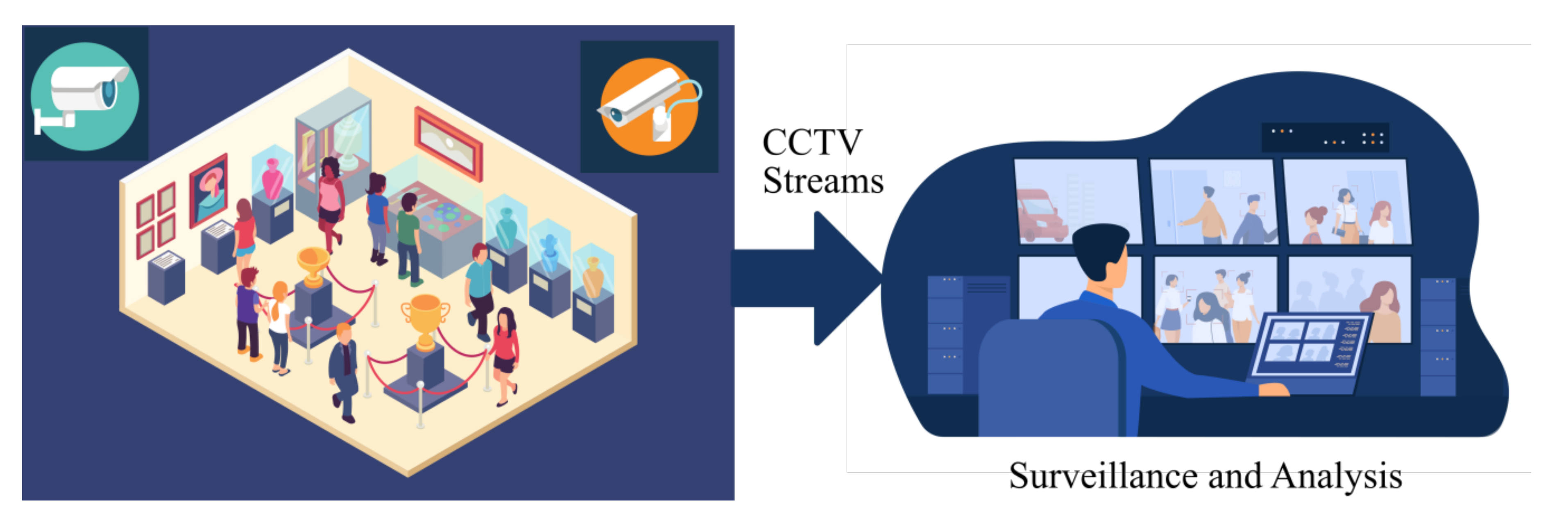



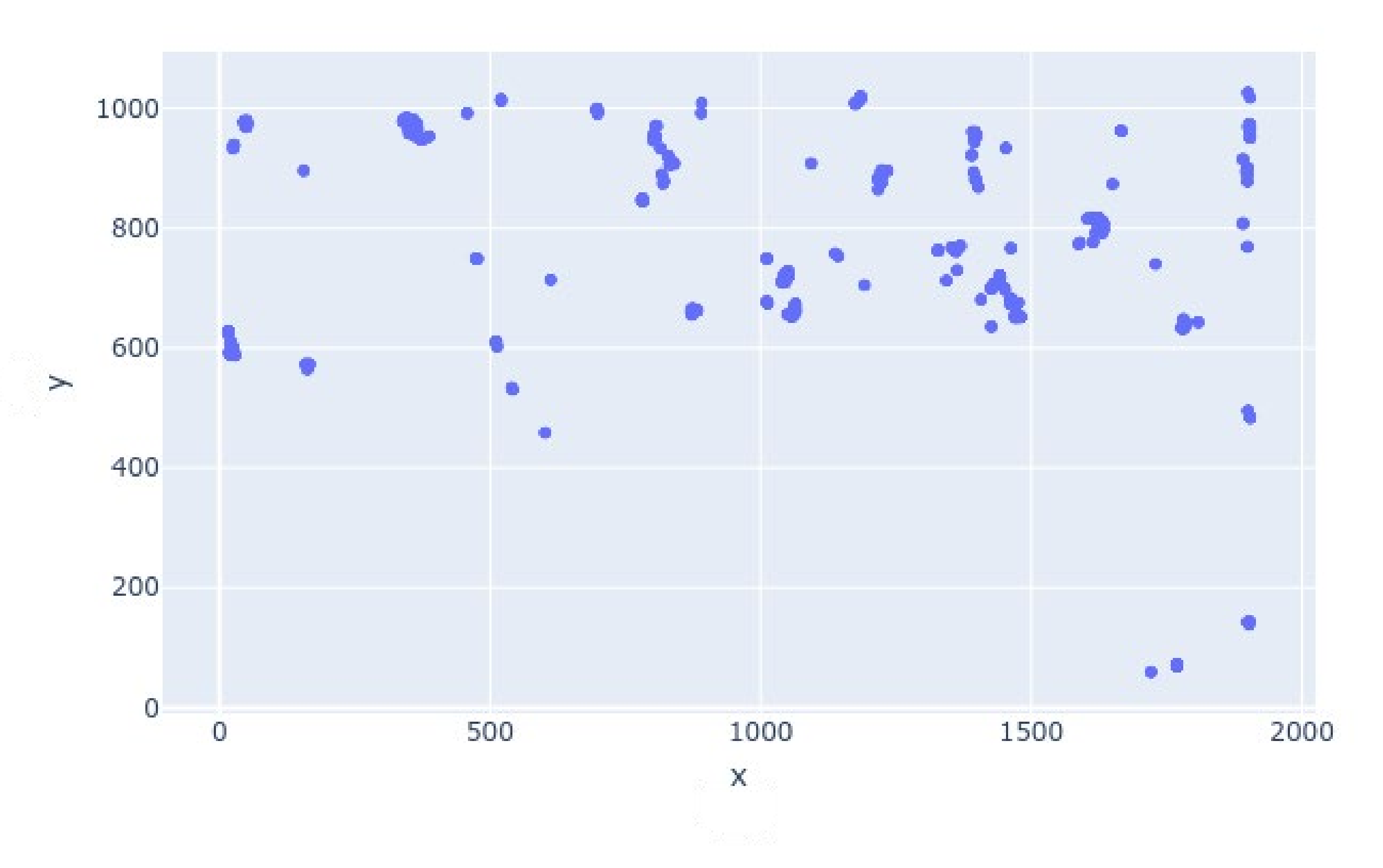
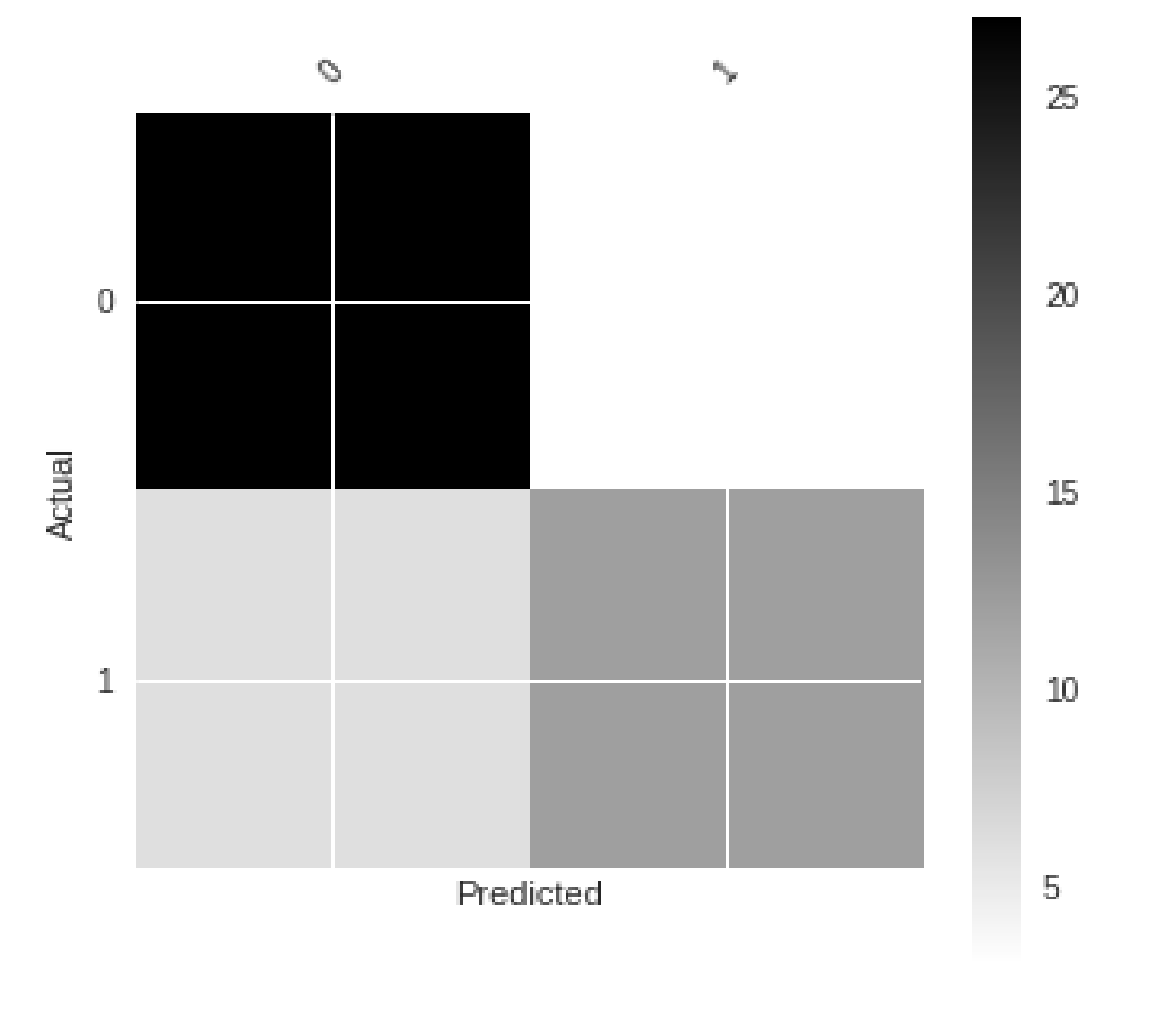

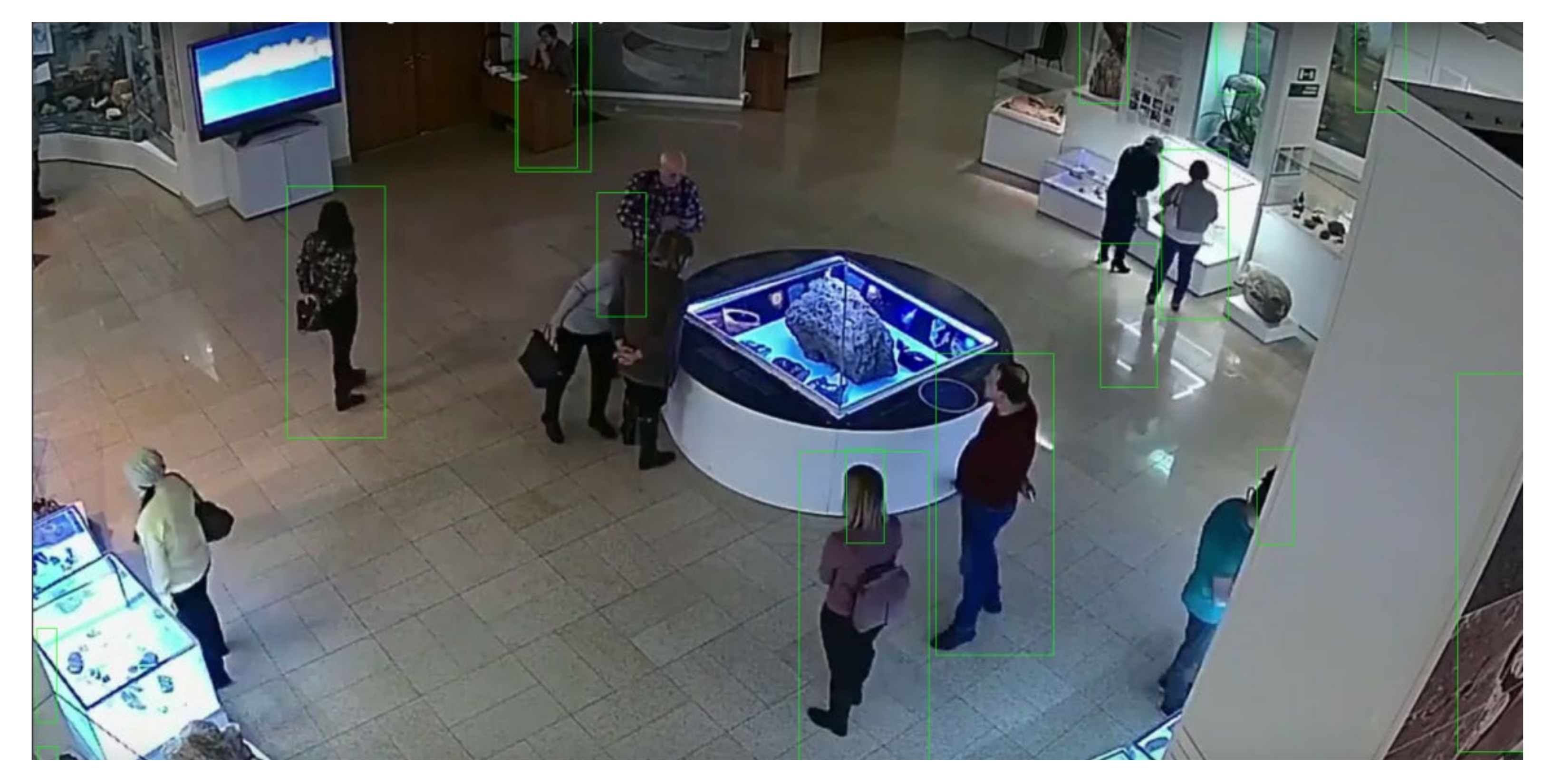

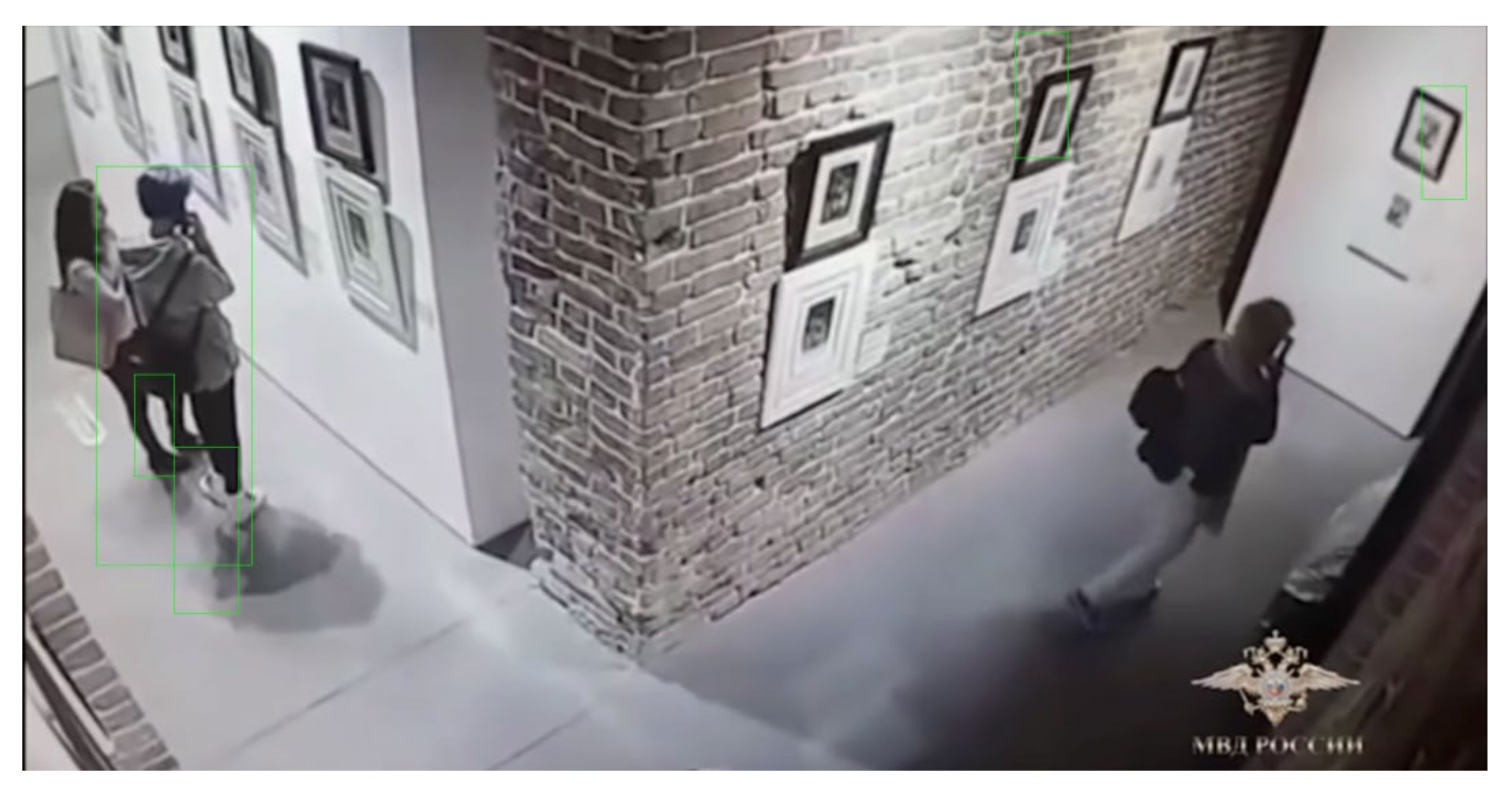
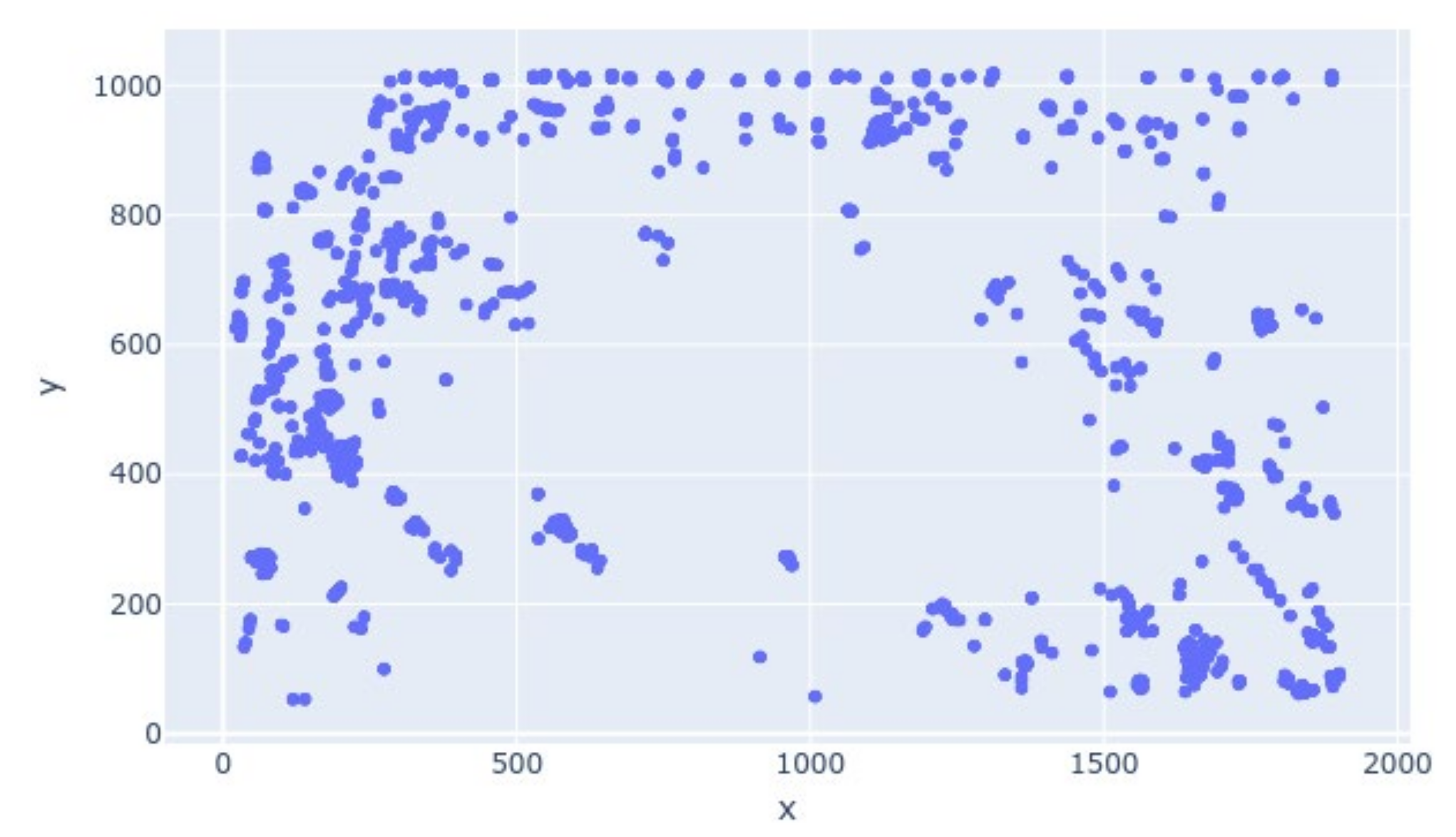
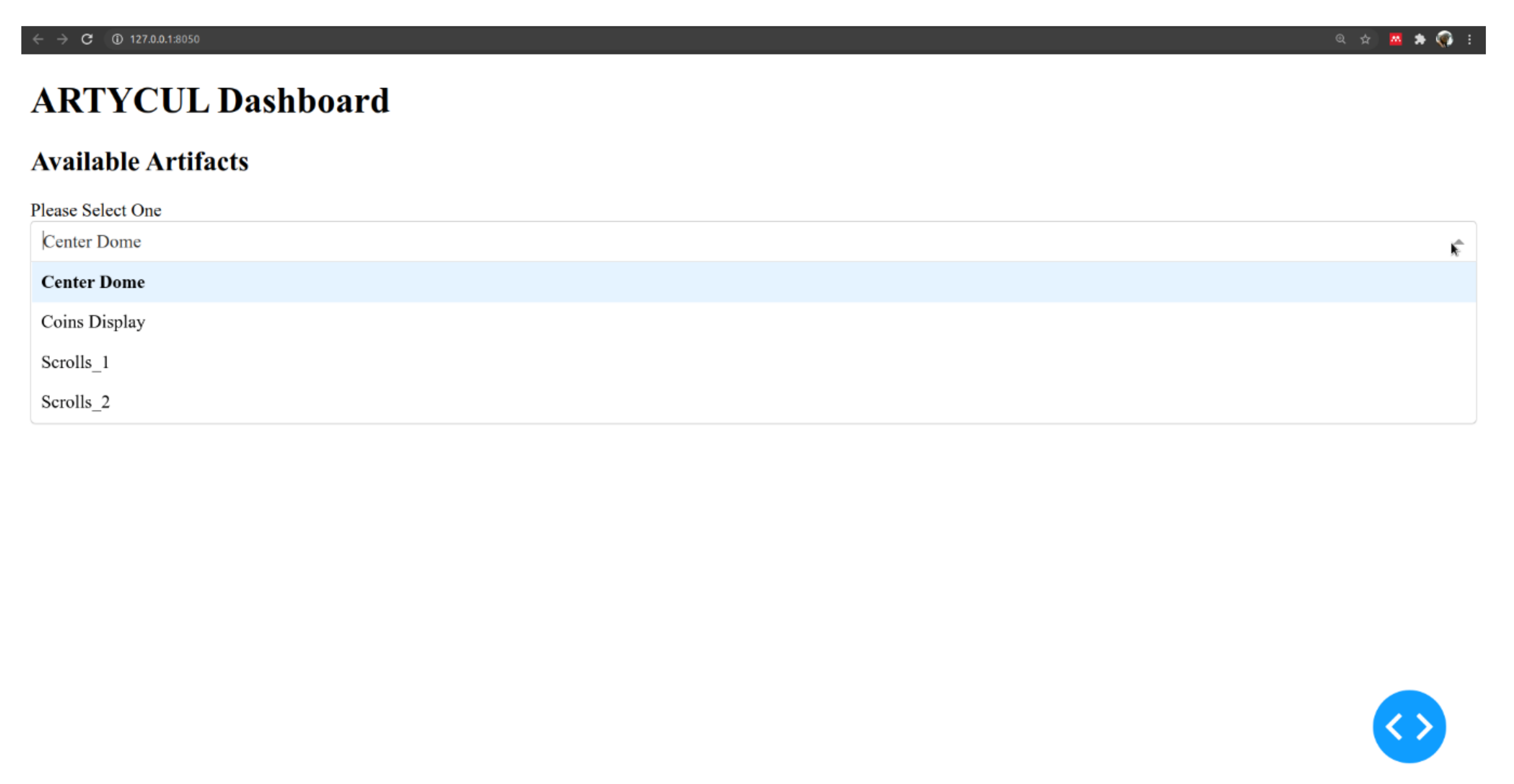
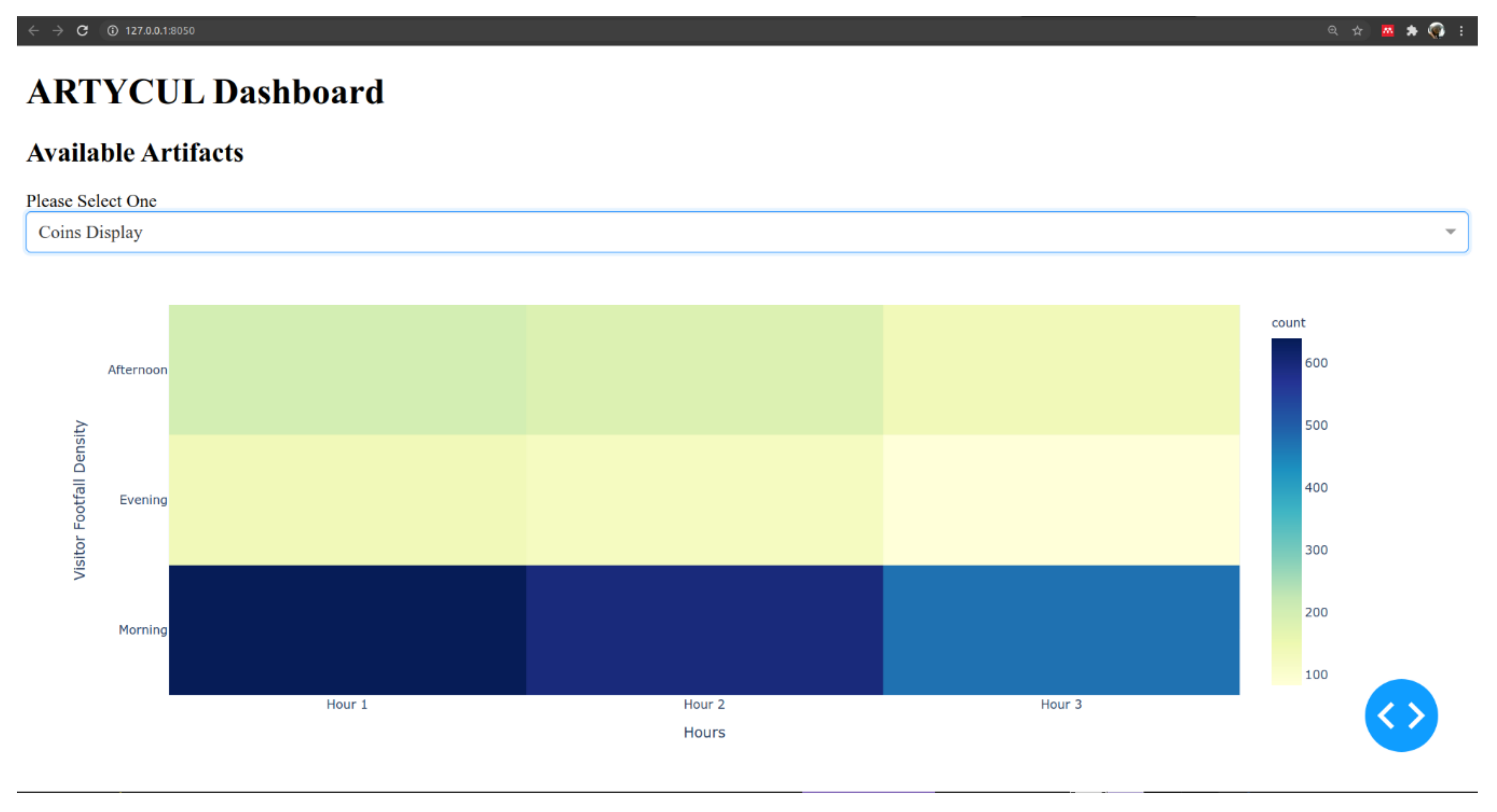
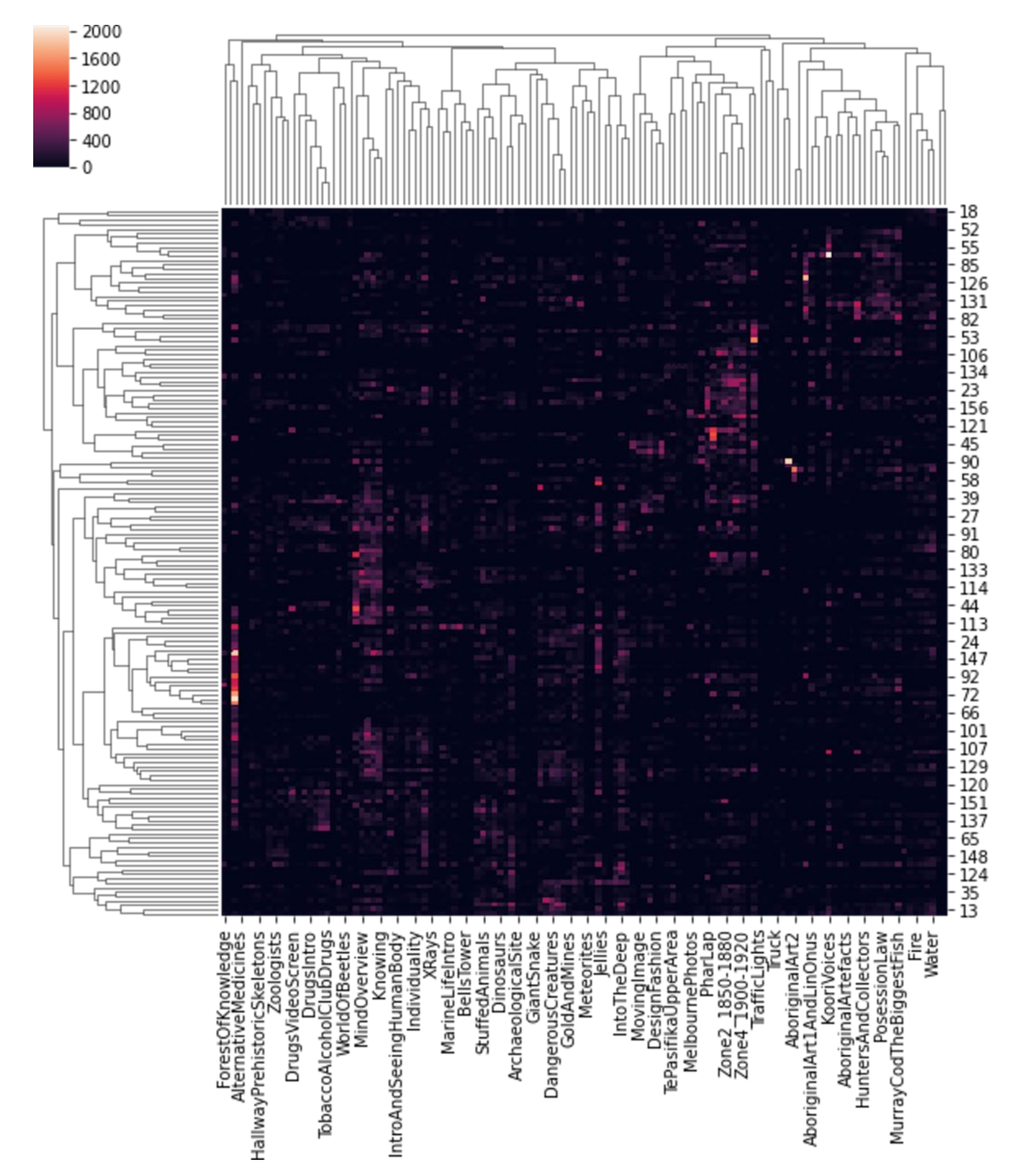
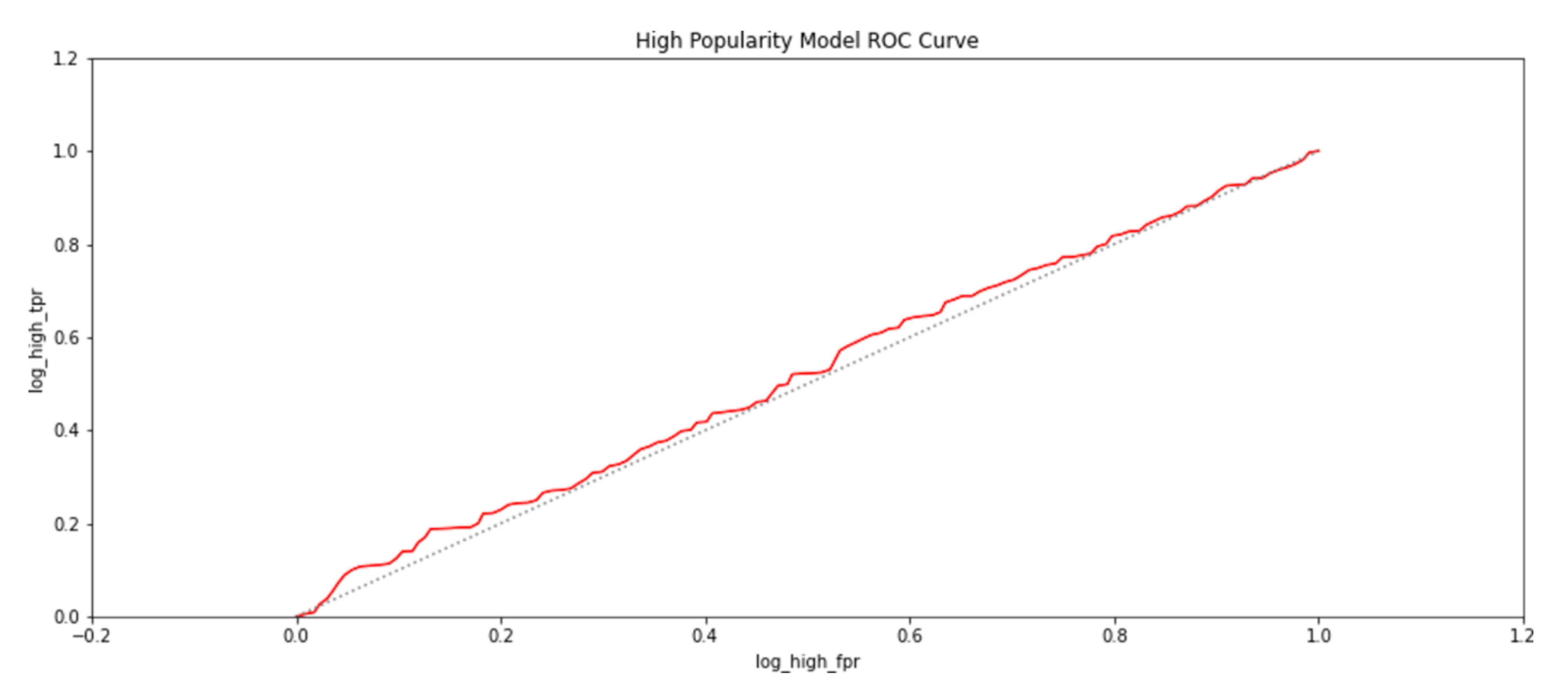
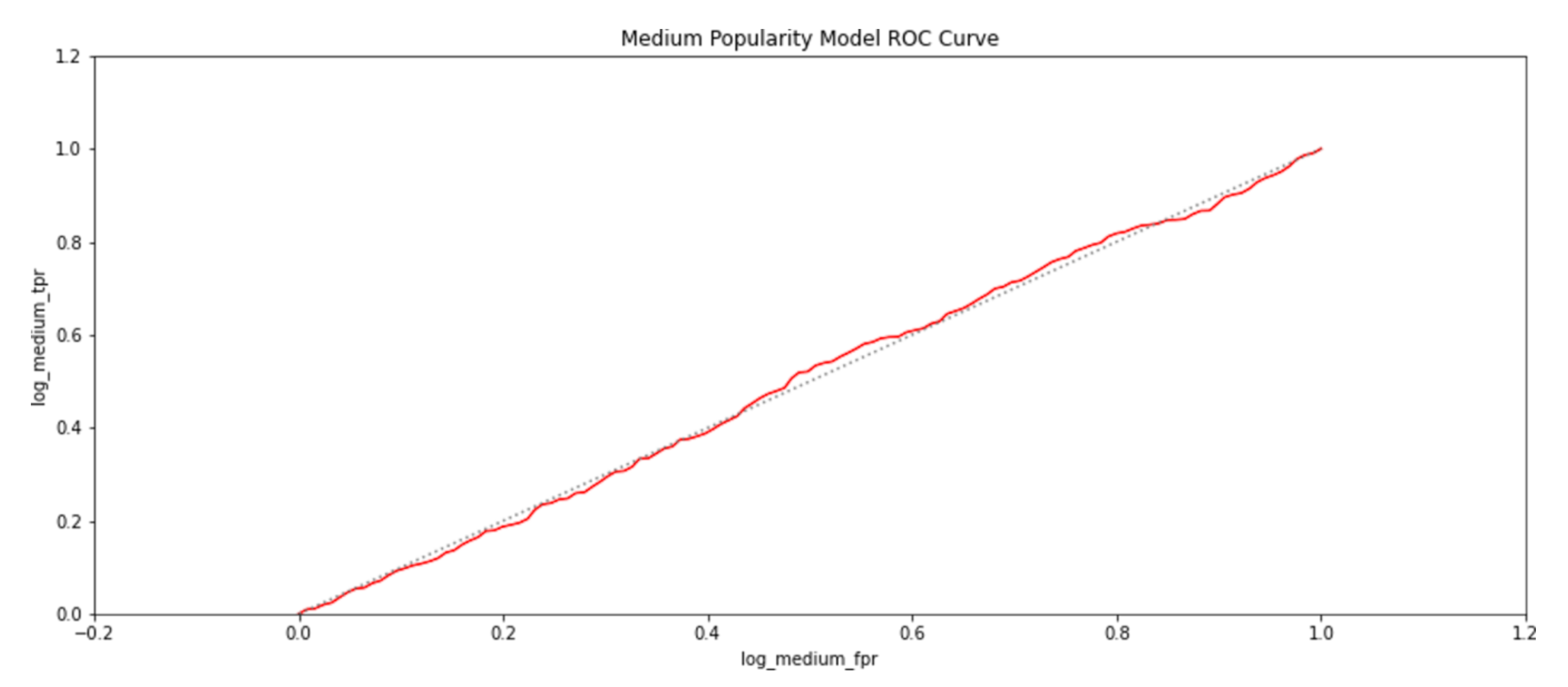
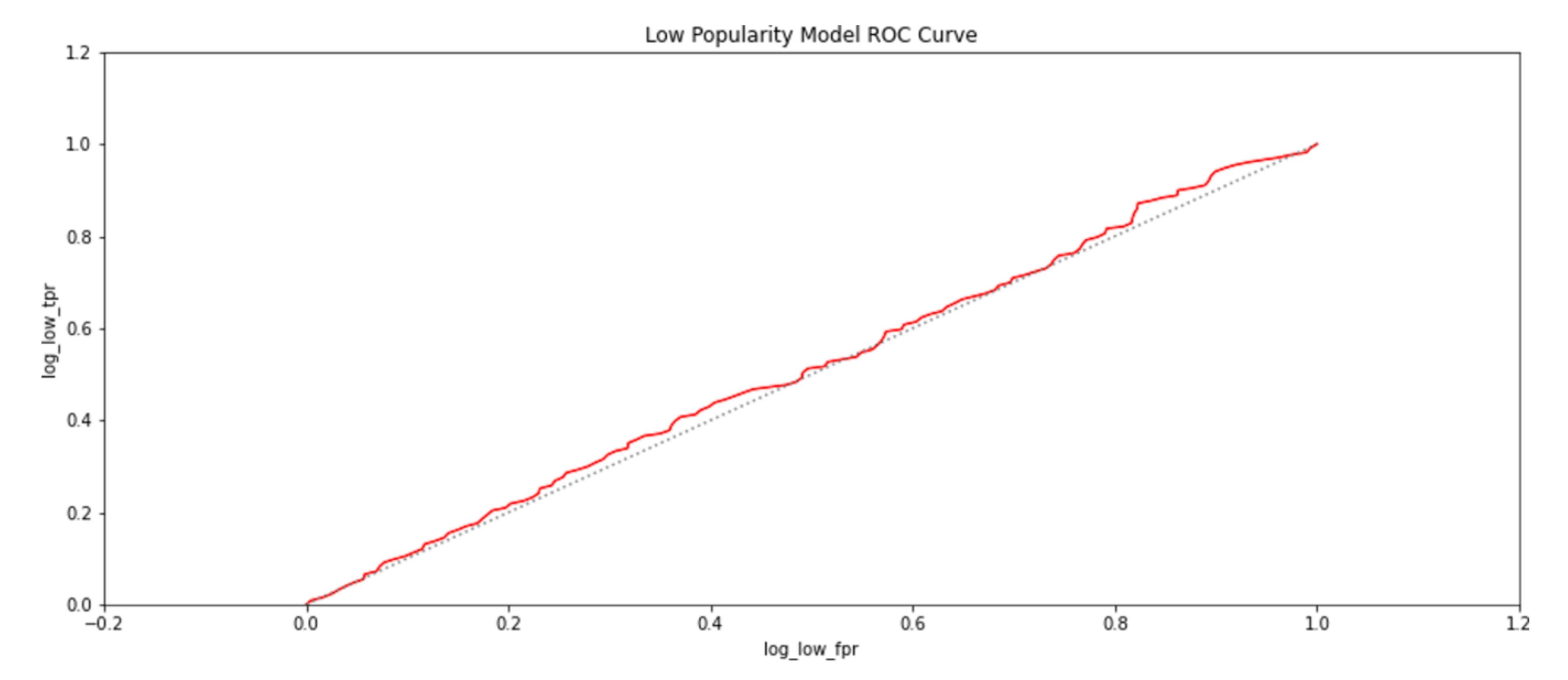
| Real-World Application | Example | Challenges Faced |
|---|---|---|
| Monitoring and control of smart network in the premises | Smart system at Maschio Angioino castle in Naples for ambient lighting | Should not overwhelm the non-technical users |
| Provide an interactive visit experience | Smart system accesses handheld devices, either owned by the site or the visitors, to track visitor interest and publish relevant information | User privacy concerns and maintenance requirements of the sophisticated hardware |
| Analytics of data generated by an IoT-based smart environment | Visitor behavior is classified and used to determine the popularity of the cultural artifacts on display | Development of sophisticated models requires technical expertise |
| True Condition | |||
|---|---|---|---|
| Predicted Condition | True (Presence) | False (Presence) | |
| True (Actual) | 0.9 | 0.16667 | |
| False (Actual) | 0.2 | 0.66667 | |
| True Condition | |||
|---|---|---|---|
| Predicted Condition | True (Presence) | False (Presence) | |
| True (Actual) | 0.9 | 0.16667 | |
| False (Actual) | 0.2 | 0.66667 | |
| 1930sStandingUpForRights | ABugsLife | AboriginalArt1AndLinOnus | AboriginalArt2 | AdvertisementADayInPompeii | Aliens | |
|---|---|---|---|---|---|---|
| 1930sStandingUpForRights | Y | N | N | N | N | N |
| ABugsLife | N | Y | N | N | N | N |
| AboriginalArt1AndLinOnus | N | N | Y | Y | N | N |
| AboriginalArt2 | N | N | Y | Y | N | N |
| AdvertisementADayInPompeii | N | N | N | N | Y | N |
| Aliens | N | N | N | N | N | Y |
Publisher’s Note: MDPI stays neutral with regard to jurisdictional claims in published maps and institutional affiliations. |
© 2021 by the authors. Licensee MDPI, Basel, Switzerland. This article is an open access article distributed under the terms and conditions of the Creative Commons Attribution (CC BY) license (http://creativecommons.org/licenses/by/4.0/).
Share and Cite
Varma, G.; Chauhan, R.; Yafi, E. ARTYCUL: A Privacy-Preserving ML-Driven Framework to Determine the Popularity of a Cultural Exhibit on Display. Sensors 2021, 21, 1527. https://doi.org/10.3390/s21041527
Varma G, Chauhan R, Yafi E. ARTYCUL: A Privacy-Preserving ML-Driven Framework to Determine the Popularity of a Cultural Exhibit on Display. Sensors. 2021; 21(4):1527. https://doi.org/10.3390/s21041527
Chicago/Turabian StyleVarma, Gatha, Ritu Chauhan, and Eiad Yafi. 2021. "ARTYCUL: A Privacy-Preserving ML-Driven Framework to Determine the Popularity of a Cultural Exhibit on Display" Sensors 21, no. 4: 1527. https://doi.org/10.3390/s21041527
APA StyleVarma, G., Chauhan, R., & Yafi, E. (2021). ARTYCUL: A Privacy-Preserving ML-Driven Framework to Determine the Popularity of a Cultural Exhibit on Display. Sensors, 21(4), 1527. https://doi.org/10.3390/s21041527







